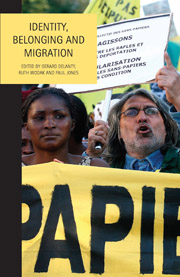Book contents
- Frontmatter
- Contents
- Acknowledgements
- List of Figures
- Notes on Contributors
- Introduction: Migration, Discrimination and Belonging in Europe
- I Theoretical Perspectives on Belonging
- II Institutional Forms of Discrimination
- III Cases of Belonging and Exclusion
- 11 Symbolic Violence
- 12 Voices of Migrants: Solidarity and Resistance
- 13 Transformations of ‘Dutchness’: From Happy Multiculturalism to the Crisis of Dutch Liberalism
- 14 Competent vs. Incompetent Students: Polarization and Social Closure in Madrid Schools
- Conclusion: Discrimination as a Modern European Legacy
- Index
11 - Symbolic Violence
from III - Cases of Belonging and Exclusion
- Frontmatter
- Contents
- Acknowledgements
- List of Figures
- Notes on Contributors
- Introduction: Migration, Discrimination and Belonging in Europe
- I Theoretical Perspectives on Belonging
- II Institutional Forms of Discrimination
- III Cases of Belonging and Exclusion
- 11 Symbolic Violence
- 12 Voices of Migrants: Solidarity and Resistance
- 13 Transformations of ‘Dutchness’: From Happy Multiculturalism to the Crisis of Dutch Liberalism
- 14 Competent vs. Incompetent Students: Polarization and Social Closure in Madrid Schools
- Conclusion: Discrimination as a Modern European Legacy
- Index
Summary
In this chapter we want to investigate the ways in which the everyday encounters between ‘natives’ and ‘foreigners’ affects the ways in which migrants think and feel about themselves. In particular, we are interested in the non-physical hurt experienced by migrants: daily and routinely migrants confront different forms of rejection that can be intimidating, humiliating and incapacitating; repeated experience of such rejections causes feelings of fear, inferiority and reserve. We wish to explore these feelings, leaving for the next chapter the task of analysing subterfuge and resistance. The interview material that we draw upon shows that some people in the street, neighbours, sales clerks as well as the public authorities and the police sometimes do their utmost to make migrants feel miserable and undesired. We will focus on how ‘natives’ – including public officials and police – communicate their hostility towards migrants relying on the gaze, the body and the simplest forms of verbal communication.
Two Meanings of Symbolic Violence
When Pierre Bourdieu introduced the term ‘symbolic violence’, he referred to positive, status-upgrading naming and bonding practices which concealed the true face of exploitation and domination in a Kabyl society he studied – a society which could not rely on the money economy, courts, police or politics to legitimate, conceal and reinforce the prevailing forms of domination (1991 [1972]: 21–31,188–92). His concept stood mainly for status upgrading through bonding and symbols.
- Type
- Chapter
- Information
- Identity, Belonging and Migration , pp. 221 - 240Publisher: Liverpool University PressPrint publication year: 2011
- 1
- Cited by



